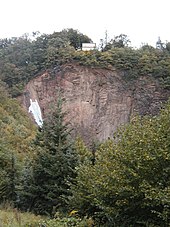Karl May Festival (Radebeul)
The Karl May holidays found annually since 1992 at the weekend after Ascension in Lößnitzgrund of Radebeul instead. In memory of the writer Karl May , the Lößnitzgrund is transformed into an impressive Wild West backdrop for three days. Around 30,000 guests come to the festival every year. The 2016 patron was Gojko Mitić , the “DEFA Chefindian” and “Winnetou of the East”.
The festivities not only contribute to the preservation of Karl May's literary heritage, but also make a significant contribution to intercultural exchange and understanding between Europeans and Native Americans. In 2016, members of Oneida were guests of the festive season for the fourth time .
The festival area runs through the wooded Lößnitzgrund, along the Lößnitzbach and the adjacent stretch of the Lößnitzgrundbahn . The Sternreitercamp is located in Radebeul- Altwahnsdorf .
procedure

Even before the start of the festival, the participants of the star ride start towards Radebeul. In 2013 there were more than 200 riders from all over Germany. The rider, who covers the longest distance to Radebeul, will be honored with an original Indian peace pipe during the big star equestrian parade on Sunday . This is traditionally presented by "Winnetou" or his "blood brother" Old Shatterhand (actor from the Theater Landesbühnen Sachsen ). In 2016 the winners came from the Lower Saxony town of Rüßen ; they covered a distance of 405 kilometers on their horses.
The festival begins on Friday evening with the grand opening event and the Freiberg Country Night. Well-known bands from the German country scene get in the mood for the beginning of the festival weekend and regional line dance clubs show their latest performances.
At the Pow Wow on the "Hohen Stein", Native Americans from a wide variety of tribes present their culture with dances, stories and chants. They enter into direct dialogue with the festival visitors and also report on their current life in America. They present their modern everyday life, for example, with film nights or rock concerts, but also with games and stories.
In numerous western camps - among them Fort Henry, White Horse, Fox Home or Fort Virginia - the life of American settlers in the 19th century is presented. Cowboys are fighting each other or drinking whiskey in the saloon, outlaws lie in wait for the Santa Fé Express to ambush its passengers and brave southerners are preparing for the American Civil War.
The musical center of the festival area is the western town "Little Tombstone". International country and bluegrass bands play and line dance groups show their skills in front of the stage. The state theaters of Saxony show scenes from their Karl May productions and the crooks Big Eddy and Locci go on a foray through the city.
In the Sternreitercamp Altwahnsdorf, riders compete in various disciplines for the winner's cup of the Freiberger Brauhaus GmbH and compete against each other at the Saxony championship in slalom and barrel races.
The Karl May Festival offers lots of adventure, especially for children. You can shimmy through a landscape of ropes in the forest, try out western games, archery, explore the area on donkeys or dig for gold in the Loessnitz River.
The traditional high point of the festive season is the star parade on Sunday on Meißner Straße. At this event, cowboys, line dancers, Indian guests and star riders pull past thousands of onlookers onto the festival area.
Web links
Individual evidence
- ↑ Winner of the Star Ride 2016. Accessed June 4, 2016.
